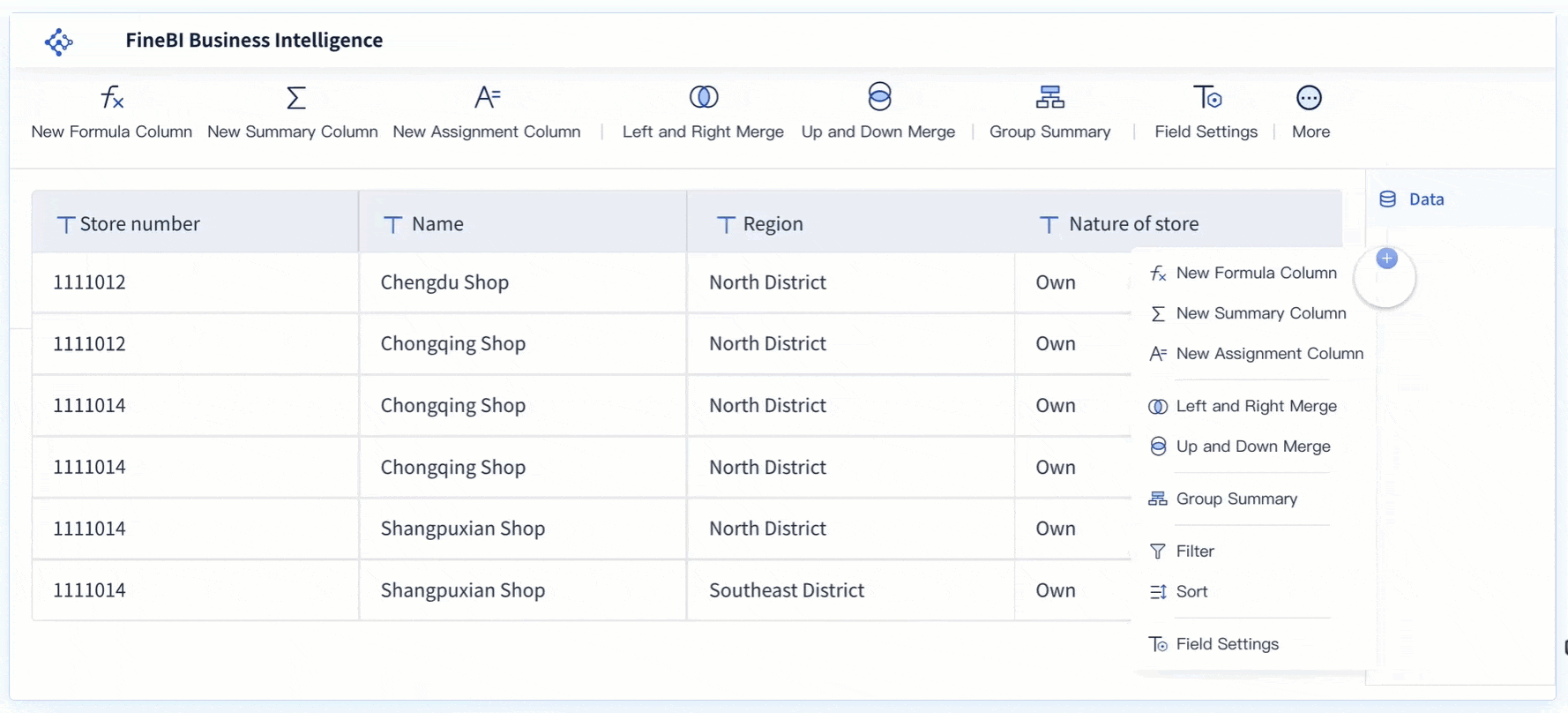

In today's business landscape, data plays a pivotal role in driving success. You rely on data to make informed decisions, understand market trends, and identify growth opportunities. However, without proper data maintenance, the potential of your data remains untapped. Effective data maintenance ensures that your data remains accurate, up-to-date, and accessible. This process helps you avoid costly errors and enhances your ability to leverage data for strategic growth. Tools like FineDataLink, FineReport, and FineBI empower you to maintain high-quality data, enabling better decision-making and operational efficiency.
Understanding Data Maintenance
Definition of Data Maintenance
Data maintenance involves the ongoing process of collecting, organizing, and managing data to ensure its accessibility and usefulness. Unlike data cleansing, which is a reactive approach, data maintenance focuses on long-term data management improvement. By maintaining your data, you ensure that it remains accurate, up-to-date, and ready for analysis.
Key Components of Data Maintenance
- Data Collection: Gathering data from various sources to ensure a comprehensive dataset.
- Data Organization: Structuring data in a way that makes it easy to access and analyze.
- Data Updating: Regularly refreshing data to keep it current and relevant.
- Data Security: Protecting data from unauthorized access and breaches.
Types of Data Maintenance
Data maintenance can be categorized into several types, each serving a unique purpose:
- Preventive Maintenance: Regularly scheduled activities to prevent data issues before they occur.
- Corrective Maintenance: Addressing and fixing data errors as they arise.
- Adaptive Maintenance: Modifying data structures to accommodate changes in business needs or technology.
- Perfective Maintenance: Enhancing data quality and performance over time.
The Role of Data Maintenance in Business
Data maintenance plays a crucial role in business operations by ensuring that data remains a reliable asset.
Ensuring Data Accuracy
Accurate data is essential for making informed business decisions. By maintaining data accuracy, you reduce the risk of errors that could lead to poor decision-making. Regular data checks and updates help in identifying and correcting inaccuracies promptly.
Maintaining Data Consistency
Consistency in data ensures that all departments within your organization are working with the same information. This uniformity prevents misunderstandings and miscommunications. By maintaining data consistency, you foster a cohesive work environment where everyone has access to reliable data.
Benefits of Effective Data Maintenance

Improved Decision Making by Data Maintenance
Data maintenance plays a pivotal role in enhancing your decision-making capabilities. By ensuring that your data is accurate and up-to-date, you can make informed decisions that drive business success.
Data-Driven Strategies
You can develop robust data-driven strategies when you have access to reliable data. These strategies allow you to identify growth opportunities and respond effectively to market trends. With proper data maintenance, you ensure that your data remains a valuable asset, guiding your strategic planning and execution.
"Access to real-time data insights and proper data governance enables confident decisions based on quality data."
Enhanced Predictive Analytics
Predictive analytics becomes more effective with well-maintained data. You can anticipate future trends and make proactive decisions that align with your business goals. By leveraging high-quality data, you enhance your ability to forecast outcomes and mitigate potential risks.
Increased Operational Efficiency
Effective data maintenance contributes significantly to operational efficiency. By streamlining processes and reducing redundancies, you can optimize your business operations.
Streamlined Processes
Maintaining your data ensures that your processes run smoothly. You can eliminate bottlenecks and improve workflow efficiency by having accurate and consistent data. This streamlining allows you to focus on core business activities and achieve your organizational goals more effectively.
Reduced Redundancies
Data maintenance helps you identify and eliminate redundancies within your systems. By ensuring that your data is organized and up-to-date, you reduce the risk of duplications and errors. This reduction in redundancies leads to cost savings and improved resource allocation, ultimately enhancing your business performance.
Consequences of Neglecting Data Maintenance
Neglecting data maintenance can lead to significant challenges for your business. When you overlook the importance of maintaining your data, you risk facing issues that can impact your decision-making and competitive edge.
Data Inaccuracy and Its Impact
Data inaccuracy poses a major threat to your business operations. When your data is incorrect or outdated, it can lead to several negative outcomes.
Poor Decision Making
Inaccurate data often results in poor decision-making. You rely on data to guide your strategic choices. When the data is flawed, your decisions may not align with reality. This misalignment can lead to missed opportunities and misguided strategies. For instance, if your sales data is inaccurate, you might invest in the wrong products or markets, leading to financial setbacks.
Financial Losses
Financial losses are a direct consequence of data inaccuracy. When you make decisions based on incorrect data, you risk investing resources in unprofitable ventures. Additionally, errors in financial data can lead to compliance issues and potential fines. Consider the case of the Massachusetts Health Center, where a data storage vendor failed to properly dispose of data. This oversight exposed the protected health information of nearly 117,000 patients, highlighting the financial and reputational risks associated with poor data maintenance.
Loss of Competitive Advantage
Neglecting data maintenance can also erode your competitive advantage. In today's fast-paced business environment, staying ahead requires accurate and timely data.
Inability to Respond to Market Changes
Without reliable data, you may struggle to respond to market changes effectively. Accurate data allows you to identify trends and adapt your strategies accordingly. When your data is outdated or inconsistent, you risk falling behind competitors who can quickly pivot based on current insights. This inability to respond can result in lost market share and diminished growth prospects.
Decreased Customer Satisfaction
Customer satisfaction hinges on your ability to understand and meet their needs. When your data is inaccurate, you may fail to deliver the products or services your customers expect. This failure can lead to dissatisfaction and a decline in customer loyalty. Maintaining accurate data ensures that you can anticipate customer demands and provide a seamless experience, fostering long-term relationships and brand loyalty.
Implementing Data Maintenance Strategies
To ensure your data remains a valuable asset, you must implement effective data maintenance strategies. These strategies help you maintain data accuracy, consistency, and security, which are crucial for business success.
Establishing Data Governance
Data governance forms the backbone of effective data maintenance. It involves setting up a framework that defines how data is managed, accessed, and protected within your organization.
Roles and Responsibilities
Assigning clear roles and responsibilities is essential for successful data governance. You need to designate individuals or teams responsible for data management tasks. This includes data stewards who oversee data quality and security. By clearly defining these roles, you ensure accountability and streamline data maintenance processes.
Medxcel, a leader in data governance, emphasizes the importance of assigning roles to ensure data consistency and quality. Their approach highlights the need for structured governance to support data analytics efforts.
Policies and Procedures
Establishing robust policies and procedures is another critical aspect of data governance. You should develop guidelines that dictate how data is collected, stored, and accessed. These policies help maintain data integrity and compliance with legal and regulatory requirements. Regularly reviewing and updating these procedures ensures they remain relevant and effective.
"About 35% of data professionals prioritize data security-related initiatives," according to Immuta’s State of Data Security Report. This underscores the importance of implementing strong governance and security controls.
Utilizing Data Management Tools
Leveraging data management tools can significantly enhance your data maintenance efforts. These tools automate processes, reduce manual errors, and improve data accessibility.
Software Solutions
Investing in reliable software solutions is crucial for efficient data management. Tools like FineDataLink, FineReport, and FineBI offer comprehensive features for data integration, reporting, and analysis. These solutions enable you to manage large volumes of data seamlessly, ensuring it remains accurate and up-to-date.
- FineDataLink: Facilitates real-time data synchronization and advanced ETL & ELT development.
- FineReport: Provides flexible reporting and diverse visualization options.
- FineBI: Empowers self-service data analysis and augmented analytics.
Automation Techniques
Automation plays a vital role in data maintenance by streamlining repetitive tasks. You can use automation techniques to schedule regular data updates, perform data cleansing, and generate reports. This reduces the burden on your team and ensures data remains current and reliable.
By implementing these data maintenance strategies, you enhance your ability to leverage data for informed decision-making and strategic growth. Prioritizing data governance and utilizing advanced tools will help you maintain high-quality data, ultimately driving business success.
Real-World Applications of Data Maintenance

Case Studies in Various Industries
Data maintenance plays a crucial role across different sectors, ensuring that businesses operate efficiently and make informed decisions. Let's explore how data maintenance impacts the retail and healthcare industries.
Retail Sector
The company reduced overstock and improved customer satisfaction by analyzing real-time sales data.
Healthcare Industry
A hospital implemented a data maintenance strategy to track patient records and treatment plans. This approach enabled the hospital to identify high-risk patients and provide timely interventions, ultimately saving lives and resources.
Lessons Learned from Successful Companies
Successful companies have demonstrated the importance of effective data maintenance. By adopting best practices and overcoming common challenges, you can ensure your data remains a valuable asset.
Best Practices
- Prioritize Data Governance: Establish clear policies and procedures for data management. This ensures data consistency and quality, leading to reliable insights.
- Invest in Technology: Use advanced tools like FineDataLink, FineReport, and FineBI to automate data processes. These tools help you maintain data accuracy and accessibility.
- Regular Data Audits: Conduct routine checks to identify and correct data inaccuracies. This practice keeps your data current and reliable.
Common Challenges
- Data Silos: Different departments may store data separately, leading to inconsistencies. Encourage collaboration and data sharing to overcome this challenge.
- Complex Data Formats: Handling diverse data formats can be challenging. Invest in tools that support various formats to streamline data integration.
- Resource Constraints: Limited resources can hinder data maintenance efforts. Prioritize critical data tasks and allocate resources efficiently.
By learning from these case studies and implementing best practices, you can harness the power of data maintenance to drive business success.
The Future of Data Maintenance
Emerging Trends
Artificial Intelligence in Data Maintenance
Artificial Intelligence (AI) is transforming how you handle data maintenance. AI solutions automate up to 70% of data processing tasks, significantly reducing manual effort. This automation allows you to focus on strategic activities rather than routine data management. AI excels in identifying patterns and creating decision-making algorithms, which enhances your ability to derive insights from complex datasets. In fields like healthcare, AI aids in predictive diagnostics, while in retail, it analyzes customer behavior to tailor marketing strategies. By integrating AI into your data maintenance processes, you can achieve faster and more accurate insights, driving better business outcomes.
Big Data and Its Implications
Big data continues to evolve, offering new opportunities for businesses. A key trend is the consolidation of data from multiple systems into a unified storage solution, such as a data warehouse or data lake. This centralization improves data quality and availability, enabling you to make more informed decisions. Additionally, advancements in quantum computing promise to revolutionize big data processing, allowing you to analyze vast amounts of data more efficiently. As the Internet of Things (IoT) grows, it contributes even more data, necessitating robust data maintenance strategies. Embracing these trends will help you stay competitive and leverage big data for strategic growth.
Preparing for Future Challenges
Adapting to Technological Advancements
To remain competitive, you must adapt to technological advancements in data maintenance. This involves staying updated with the latest tools and techniques that enhance data processing and analysis. By embracing new technologies, you can improve your data management capabilities and respond effectively to changing business needs. For instance, adopting AI-driven data maintenance solutions can streamline your operations and provide real-time insights. Keeping pace with technological advancements ensures that your data remains a valuable asset, supporting your business objectives.
Continuous Improvement
Continuous improvement is essential for effective data maintenance. Regularly reviewing and updating your data management practices helps you identify areas for enhancement. Implementing feedback loops and performance metrics allows you to measure the effectiveness of your data maintenance strategies. By fostering a culture of continuous improvement, you ensure that your data remains accurate, consistent, and secure. This proactive approach enables you to address potential challenges before they impact your business, ensuring long-term success.
"Data governance and security are increasingly prioritizing stronger controls and modern approaches," highlighting the importance of continuous improvement in data maintenance practices.
By understanding these emerging trends and preparing for future challenges, you can enhance your data maintenance efforts and drive business success. Embracing AI and big data advancements, while focusing on continuous improvement, will position you to leverage data as a strategic asset.
Encouraging a Data-Driven Culture with Data Maintenance
Promoting Data Literacy
To foster a data-driven culture, you must prioritize data literacy within your organization. This involves equipping your team with the skills and knowledge needed to understand and utilize data effectively.
Training and Development
Invest in training programs that enhance your team's data skills. By offering workshops and courses, you can improve their ability to analyze and interpret data. For instance, the Medxcel team focused on improving internal skills around tools like Azure and Power BI. This approach not only boosts individual capabilities but also strengthens your organization's overall data competency.
Encouraging Data-Driven Decision Making
Encourage your team to base their decisions on data rather than intuition. You can achieve this by integrating data analysis into everyday business processes. At ShopRunner, executives model data-based decision-making, setting an example for the rest of the team. By emphasizing the importance of data in decision-making, you create an environment where data becomes a central part of your strategic planning.
Fostering Collaboration
Collaboration across departments is essential for a successful data-driven culture. By breaking down silos, you ensure that data flows freely throughout your organization, enhancing its value.
Cross-Departmental Teams
Form cross-departmental teams to tackle data-related projects. This approach encourages diverse perspectives and fosters innovation. When different departments work together, they can share insights and develop comprehensive solutions. This collaboration bridges the gap between technical and non-technical staff, empowering everyone to contribute to data-driven initiatives.
Sharing Best Practices
Promote the sharing of best practices within your organization. Encourage teams to document and share their successful data strategies. This practice not only spreads knowledge but also helps avoid common pitfalls. By learning from each other's experiences, your organization can continuously improve its data maintenance efforts.
By promoting data literacy and fostering collaboration, you can cultivate a data-driven culture that leverages data maintenance for strategic growth. Prioritizing these elements ensures that your organization remains agile and competitive in today's data-centric business landscape.
FanRuan's Role in Data Maintenance
In the realm of data maintenance, FanRuan stands out with its innovative solutions that streamline data processes and enhance business intelligence. By leveraging tools like FineDataLink, FineReport, and FineBI, you can ensure your data remains accurate, accessible, and actionable.
FineDataLink for Data Integration
FineDataLink serves as a comprehensive platform for data integration, simplifying complex tasks and ensuring seamless data flow across your organization.
Real-Time Data Synchronization
With FineDataLink, you achieve real-time data synchronization, which keeps your data updated across multiple systems. This capability allows you to make timely decisions based on the most current information. Real-time synchronization reduces latency, ensuring that your business operations run smoothly without interruptions.

Advanced ETL & ELT Development
The platform also excels in advanced ETL (Extract, Transform, Load) and ELT (Extract, Load, Transform) development. These processes enable you to efficiently manage large volumes of data, transforming raw data into valuable insights. By automating these tasks, FineDataLink minimizes manual effort and reduces the risk of errors, enhancing overall data quality.
FineReport for Reporting and Analytics
FineReport offers robust reporting and analytics capabilities, empowering you to create detailed reports and visualizations that drive informed decision-making.
Flexible Report Designer
The flexible report designer in FineReport allows you to generate reports quickly and easily. Its drag-and-drop interface simplifies the creation of complex reports, enabling you to tailor them to your specific needs. This flexibility ensures that you can present data in a way that is both informative and visually appealing.

Diverse Visualization Types
With FineReport, you have access to a wide range of visualization types. These diverse options allow you to represent data in various formats, making it easier to uncover insights and communicate findings effectively. Whether you need charts, graphs, or dashboards, FineReport provides the tools to visualize data comprehensively.
FineBI for Business Intelligence
FineBI enhances your business intelligence efforts by offering self-service data analysis and augmented analytics.
Self-Service Data Analysis
FineBI empowers you to perform self-service data analysis, enabling you to explore data independently without relying on IT support. This autonomy allows you to quickly identify trends, track key performance indicators, and make data-driven decisions. By democratizing data access, FineBI fosters a culture of data literacy within your organization.

Augmented Analytics
The platform also features augmented analytics, which leverages advanced algorithms to automate data analysis. This capability helps you uncover hidden patterns and generate predictive insights, enhancing your ability to anticipate future outcomes. With FineBI, you can transform raw data into actionable intelligence, driving strategic growth and innovation.
By integrating these powerful tools into your data maintenance strategy, you can optimize data management processes and unlock the full potential of your data assets. FanRuan's solutions provide the foundation for a robust data-driven approach, ensuring your business remains competitive and successful.
Data maintenance is essential for ensuring your business data remains accurate and reliable. By prioritizing data maintenance, you streamline processes and improve decision-making. This proactive approach helps you avoid potential losses due to poor data quality.
To achieve this, consider consulting experts or utilizing tools like FineDataLink, FineReport, and FineBI. These resources empower you to maintain high-quality data, ultimately driving your business success.
FAQ
Data maintenance involves the continuous process of managing your data to ensure its accuracy, consistency, and accessibility. It includes activities like data collection, organization, updating, and security.
Proper data maintenance ensures that your data remains reliable and up-to-date. This reliability supports informed decision-making, enhances operational efficiency, and helps maintain a competitive edge in the market.
While data cleansing focuses on correcting errors in existing data, data maintenance is a proactive approach that involves ongoing management to prevent issues. It ensures long-term data quality and usability.
Effective data maintenance includes data collection, organization, updating, and security. Each component plays a crucial role in maintaining the integrity and usefulness of your data.
Automation streamlines repetitive tasks such as data updates and cleansing. By reducing manual effort, automation minimizes errors and ensures that your data remains current and accurate.
Tools like FineDataLink, FineReport, and FineBI offer comprehensive solutions for data integration, reporting, and analysis. These tools help you manage large volumes of data efficiently and maintain its quality.
Regular data maintenance is essential. The frequency depends on your business needs and data volume. However, routine checks and updates should be part of your ongoing data management strategy.
Common challenges include data silos, complex data formats, and resource constraints. Addressing these challenges requires collaboration, investment in technology, and efficient resource allocation.
Continue Reading About Data Maintenance
How to Quickly Build a Core App Dashboard
Quickly build a core app dashboard with essential features, user-friendly design, and advanced customization options for enhanced user experience.
Lewis
Aug 23, 2024
2025 Best Data Integration Solutions and Selection Guide
Explore top data integration solutions for 2025, enhancing data management and operational efficiency with leading platforms like Fivetran and Talend.
Howard
Dec 19, 2024
2025's Best Data Validation Tools: Top 7 Picks
Explore the top 7 data validation tools of 2025, featuring key features, benefits, user experiences, and pricing to ensure accurate and reliable data.
Howard
Aug 09, 2024
2025 Data Pipeline Examples: Learn & Master with Ease!
Unlock 2025’s Data Pipeline Examples! Discover how they automate data flow, boost quality, and deliver real-time insights for smarter business decisions.
Howard
Feb 24, 2025
15 Best Software Reporting Tools for 2025
Explore the top 15 software reporting tools for 2025. Compare features, pricing, and usability to find the best fit for your business needs.
Lewis
Oct 08, 2024
Best Data Integration Vendors for Seamless Workflows
Discover the top 20 data integration vendors of 2025 for seamless workflows. Compare tools like Talend, AWS Glue, and Fivetran to optimize your data processes.
Howard
Jan 22, 2025





